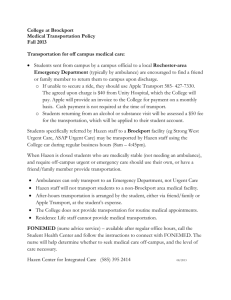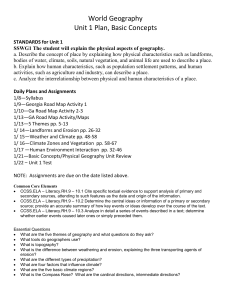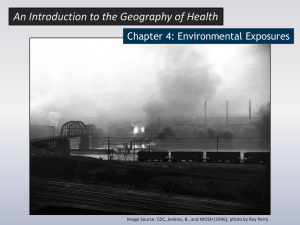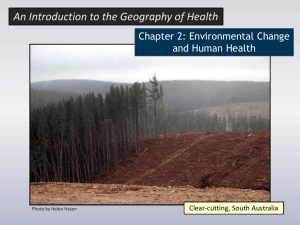Using overlays to estimate risk
advertisement
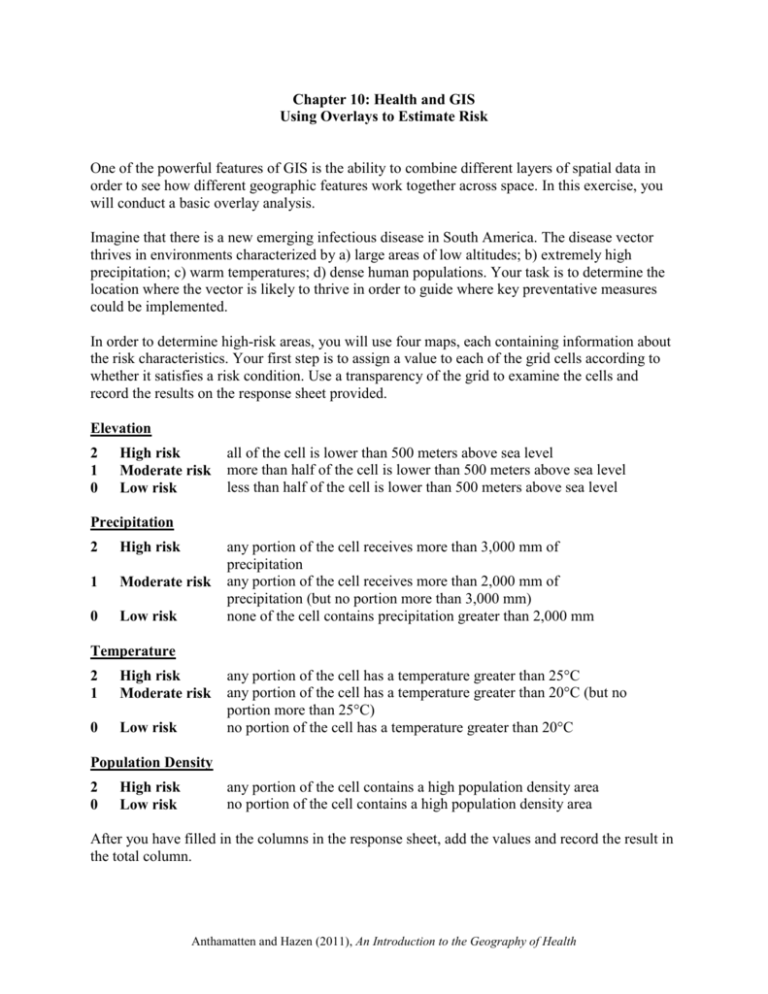
Chapter 10: Health and GIS Using Overlays to Estimate Risk One of the powerful features of GIS is the ability to combine different layers of spatial data in order to see how different geographic features work together across space. In this exercise, you will conduct a basic overlay analysis. Imagine that there is a new emerging infectious disease in South America. The disease vector thrives in environments characterized by a) large areas of low altitudes; b) extremely high precipitation; c) warm temperatures; d) dense human populations. Your task is to determine the location where the vector is likely to thrive in order to guide where key preventative measures could be implemented. In order to determine high-risk areas, you will use four maps, each containing information about the risk characteristics. Your first step is to assign a value to each of the grid cells according to whether it satisfies a risk condition. Use a transparency of the grid to examine the cells and record the results on the response sheet provided. Elevation 2 1 0 High risk Moderate risk Low risk all of the cell is lower than 500 meters above sea level more than half of the cell is lower than 500 meters above sea level less than half of the cell is lower than 500 meters above sea level Precipitation 2 High risk 1 Moderate risk 0 Low risk any portion of the cell receives more than 3,000 mm of precipitation any portion of the cell receives more than 2,000 mm of precipitation (but no portion more than 3,000 mm) none of the cell contains precipitation greater than 2,000 mm Temperature 2 1 High risk Moderate risk 0 Low risk any portion of the cell has a temperature greater than 25°C any portion of the cell has a temperature greater than 20°C (but no portion more than 25°C) no portion of the cell has a temperature greater than 20°C Population Density 2 0 High risk Low risk any portion of the cell contains a high population density area no portion of the cell contains a high population density area After you have filled in the columns in the response sheet, add the values and record the result in the total column. Anthamatten and Hazen (2011), An Introduction to the Geography of Health Response Sheet ELV A1 A2 A3 A4 A5 A6 B1 B2 B3 B4 B5 B6 B7 C1 C2 C3 C4 C5 C6 C7 C8 C9 C10 C11 C12 C13 C14 D1 D2 D3 D4 D5 D6 D7 D8 D9 D10 D11 D12 D13 E1 E2 E3 PRC TMP POP TOTAL ELV PRC TMP POP TOTAL E4 E5 E6 E7 E8 E9 E10 E11 E12 F2 F3 F4 F5 F6 F7 F8 F9 F10 F11 G2 G3 G4 G5 G6 G7 G8 G9 G10 H3 H4 H5 H6 H7 H8 I4 I5 I6 I7 I8 J4 J5 J6 J7 Anthamatten and Hazen (2011), An Introduction to the Geography of Health Response Sheet 1. Use the map template provided to produce a map of your results by appropriately shading the legend and cells to match the data you collected. How would you describe the location and distribution of “high-risk areas”? 2. Which countries would most likely be affected by this emerging infectious disease? 3. Neither the data in this exercise nor the grid used for the analysis is very precise. How important do you think that precision is for this kind of analysis? 4. If you were conducting a follow-up to the analysis, what kinds of data do you think would be important to include in a study to model the vector’s distribution? Anthamatten and Hazen (2011), An Introduction to the Geography of Health Grid Anthamatten and Hazen (2011), An Introduction to the Geography of Health Elevation Anthamatten and Hazen (2011), An Introduction to the Geography of Health Precipitation Anthamatten and Hazen (2011), An Introduction to the Geography of Health Temperature Anthamatten and Hazen (2011), An Introduction to the Geography of Health Population Density Anthamatten and Hazen (2011), An Introduction to the Geography of Health Map Template Anthamatten and Hazen (2011), An Introduction to the Geography of Health Sources Centro Internacional de Agricultura Tropical (CIAT), United Nations Environment Program (UNEP), Center for International Earth Science Information Network (CIESIN), Columbia University, and the World Bank. (2005) Latin American and Caribbean Population Database. Version 3. Available: <http://www.na.unep.net/datasets/datalist.php3> or <http://gisweb.ciat.cgiar.org/population/dataset.htm> Legates, D. R. and Willmott, C. J. (1990) ‘Mean seasonal and spatial variability in gaugecorrected, global precipitation’, International Journal of Climatology, 10: 111–27. United States Geological Survey Earth Resources Observation and Science Center. (1996) Global 30 Arc-Second Elevation (GTOPO30) [Online]. United States Geological Survey. Available: <http://eros.usgs.gov/#/Find_Data/Products_and_Data_Available/GTOPO30> (Accessed 03 November 2010). Anthamatten and Hazen (2011), An Introduction to the Geography of Health
